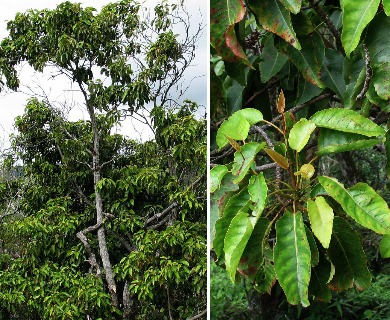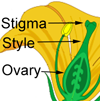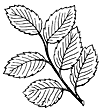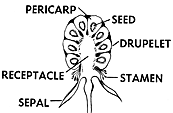Kalia
Elaeocarpus bifidus
Cluster Flower Trees family (Elaeocarpaceae)
Native species ()
Medium-sized tree of wet forests of Kauai and Oahu, with hairless leaves, small greenish flowers, and shiny dark brown stone To about 30 ft (9 ) tall and 1 ft (0.3 ) in trunk diameter. Bark is dark gray, rough, thin, fibrous. Branches and twigs are slender, drooping hairless, ending in a gummy or varnished bud.

©2005 David Eickhoff
Flower clusters () at leaf bases, unbranched, 1 1⁄4–3 1⁄4 inches (3–8 ) long. Flowers 5–8 on stalks of 3⁄8 inch (1 ), almost 3⁄8 inch (1 ) long, pale greenish yellow, narrowly bell-shaped, composed of 4–5 thick pointed 5⁄16 inch (8 ) long, 4–5 thick, narrowed and notched petals as long as 14–21 on a much shorter than petals, and with egg-shaped 2–3-celled short and 2–3-forked
Stone () elliptical and olive-shaped or rounded, about 3⁄4–1 inch (2–2.5 ) long, shiny dark brown, with thick hard stone, single-seeded.
Wood is whitish, soft, fine-textured, and straight grained. Wood of a different species, Elaeocarpus joga Merrill from Guam, in tests was found suitable for interior parts in furniture.
Hawaiians formerly made rope from the fibrous bark. The larger branches served for house rafters, and the slender ones for thatching rods.
Some flower clusters are deformed by mites and become bright red as if showy flowers. The trees are attacked by mistletoes also.
Common in wet forests at 300–4000 ft (91–1219 ) on Kauai and on both ranges of Oahu. Reported from Niihau in 1832.
Special areas
Kokee, Waimea Arboretum.
Range
Known only from Kauai and Oahu.
This and family are also united within the linden (basswood) family (Tiliaceae).






